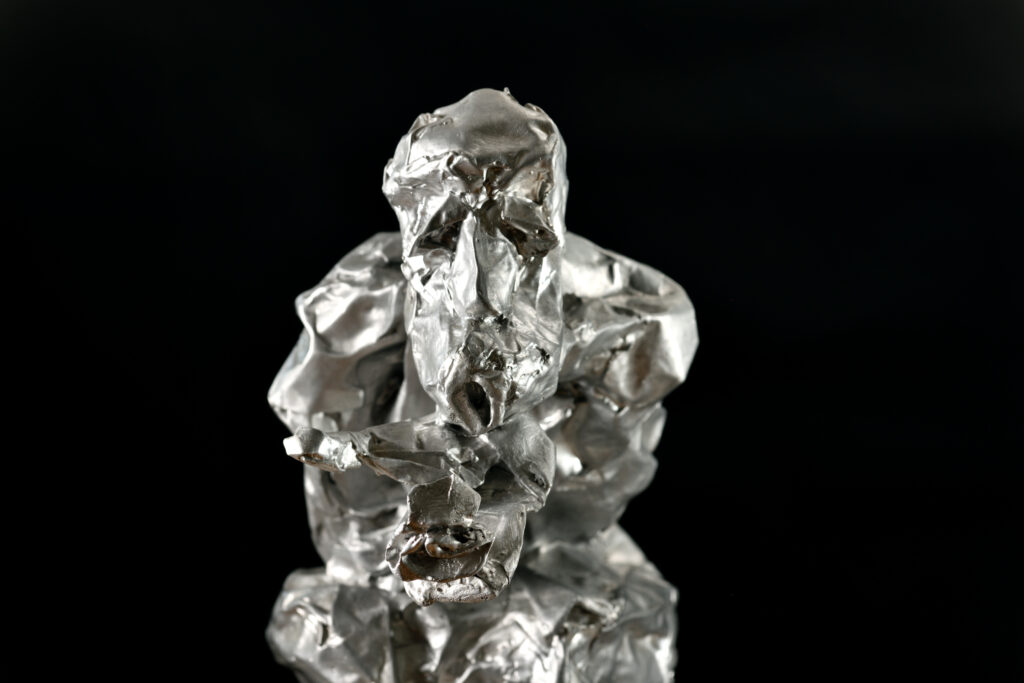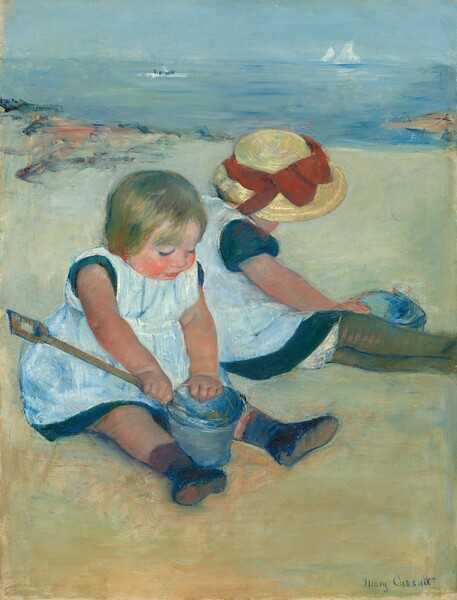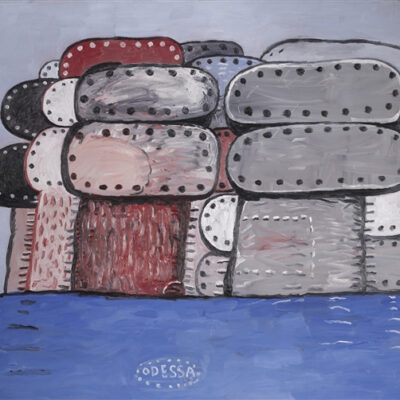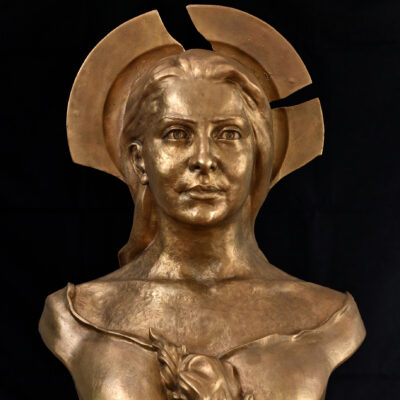Acceleration aptly describes the often frantic pace of contemporary life. Deadlines looming, “by yesterday” has replaced “asap” to express the ever more urgent nature of the rat race we may increasingly find ourselves caught up in. Portable electronic devices relentlessly compel us to be accountable and on task 24/7. Now commonplace thanks to the pandemic, the remote workplace or home office have blurred the boundaries between work and personal life to such an extent that they have become inextricably intertwined. Multi-tasking ranks high on the list of crucial skills for survival as we speed through life trying to keep up with the seconds ticking away on the chronometer. Under pressure to accomplish more and improve performance in optimal time, the unflinching overachiever, with blinders firmly attached and nose constantly to the grindstone, submits to a kind of tunnel vision that can send them hurtling off a cliff into the abyss of burnout. My latest sculpture, titled In Reverie, from the series “Finding Ways” offers an antidote to this vicious circle of frenzy and frazzle.

Dr Gindi, In Reverie, Aluminium, 35x20x35 cm.
The seated female figure leans forward in contemplation of a flower she is holding in her hand. Although at first glance one might be reminded of the similar stance in French sculptor Auguste Rodin’s iconic and inimitable The Thinker, whose crouching muscular physique and downward gaze conveys the tense masculine energy and rigid structure of the Cartesian thought-process, In Reverie channels an entirely different kind of vitality. Focused on the bloom, perhaps a dandelion—the bright yellow wildflower, whose edible leaves are a source of nourishment, matures to form a perfect sphere of delicate seed pods that scatter in the wind—the young maiden purses her lips to blow the petals or seedlings into the air, suggesting an intimate connection to nature and the life cycle of all beings but also the infinite cosmos beyond. Unlike The Thinker, with his furrowed brow and chin buried in his hand evoking solitude and consternation from being mired in thoughts of human plight perhaps, In Reverie conjures a state of interconnectivity and fullness, quite literally breathing life into matter, a gesture that nods to the creative process itself.

Buddha, early 7th century China.
This contemplative mood is echoed in countless representations of Buddha, such as this exquisite time-worn early seventh-century lacquer effigy from China. The placement of his hands, now lost, in his lap indicates meditation, a practice leading to understanding, fulfillment, and eventual enlightenment, which his serene countenance also conveys. The slightly downward tilt of the head, the dreamy eyes lowered and fixed on a point beyond, the relaxed upper body balanced in lotus position, even the graceful folds of the robe, all exude the soothing inner glow of the blissful state of nirvana he embodies and foster a sense of tranquil mindfulness in the viewer.

Mary Cassatt, Children Playing on the Beach, 1884.
In a more down-to-earth and grounded manner, the pure absorption and delight of child’s play never cease to fascinate our adult minds, and many artists have endeavored to portray their insouciance and unfettered creativity. In Children Playing on the Beach (1884), nineteenth-century American painter Mary Cassatt captures the simple rapture of two youngsters immersed in the joy of digging in the sand. Heightened by the lulling sound of gentle waves rising and ebbing, the soft caress of the sea breeze, and the enveloping warmth of sunshine conjured by seaside setting rendered with a muted palette, the little girls relaxing on the shoreline incite the viewer to revel in this instant of time suspended.

Caspar David Friedrich, Chalk Cliffs on Rügen, 1818.
Turning their sights on the majesty of the natural world as a limitless source of inspiration, artists have sought to elicit experiences of awe and reverie. The imagery of dramatic landscapes, such as German Romantic painter Caspar David Friedrich’s Chalk Cliffs on Rügen (1818), transports the viewer into a subliminal realm by representing “not only what he has in front of him but also what he sees inside himself,” a statement that reveals how the artist envisioned his task. The pristine beauty of vertiginous otherworldly white cliffs and more pacifying presence of leafy boughs, curving overhead and casting their comforting shade onto the grassy clearing, frame the view outward into the vast yonder, where sea and sky blend together to efface the horizon line. Perched above the abyss, together yet apart in solitary splendor, a lady dressed in red and two dark suited gentlemen with their backs to the viewer. By way of the “Rückenfigur” pictorial device, Friedrich directs our gaze both inward to the center of the composition and outward to the vista of the all-consuming immensity of the universe at land’s end. The painter thus brilliantly depicts his own vision of what pictorial representation should accomplish. Yet on second glance, the man the middle, on hands and knees, appears to be concerned with something more terrestrial.

Dr Gindi, In Reverie, Aluminium, 35x20x35 cm.
This crouching figure brings me back to In Reverie and the sculpted gesture of the woman transfixed in a fleeting moment, training her eyes on the ephemeral blossom and blowing the seeds every which way. The act itself invoking the inward/outward spiraling motion of the meditative mind—the permeability of the subconscious and cosmic consciousness. This oneiric instant encapsulates the boundless fecundity of nature and the limitless potential of the imagination to sow and cultivate the invisible life that nurtures our soul. The sculpture beckons to us, imploring us to slow down, allowing ourselves to linger and breathe in the blissful sensation of infinity.
For more information about Dr Gindi and to inquire about her sculptures go to dr-gindi.com or @gindisculptor.




